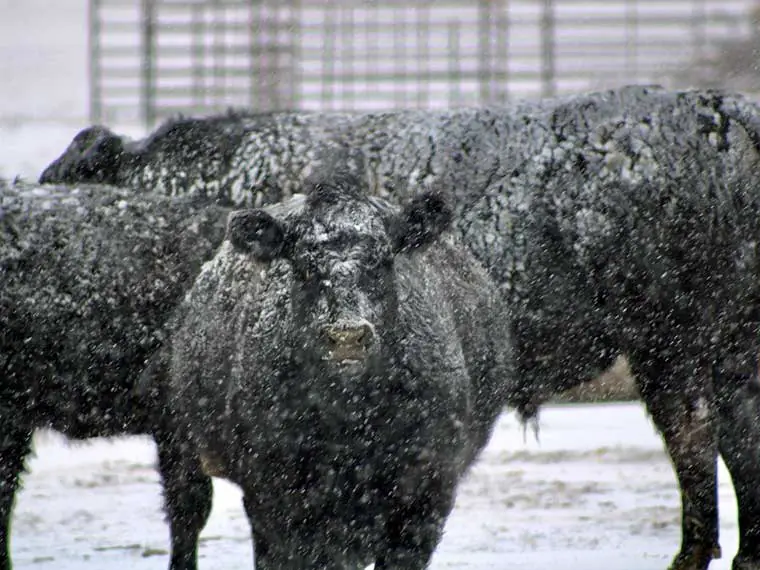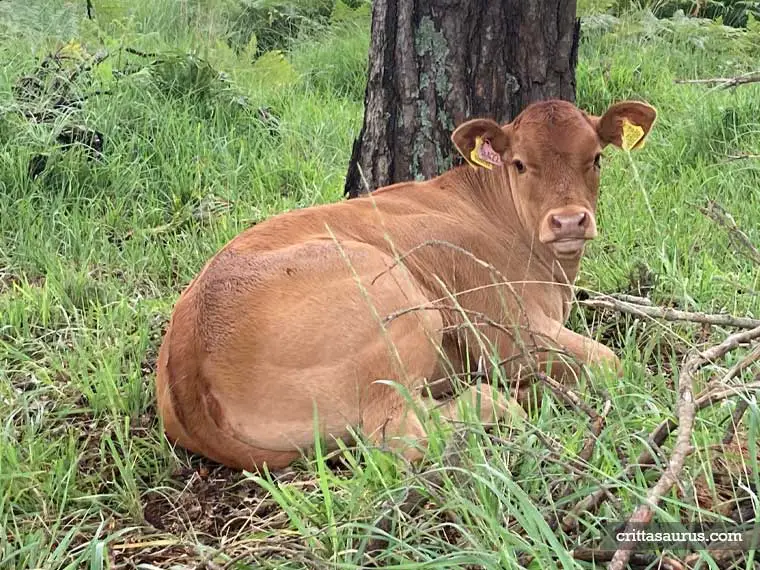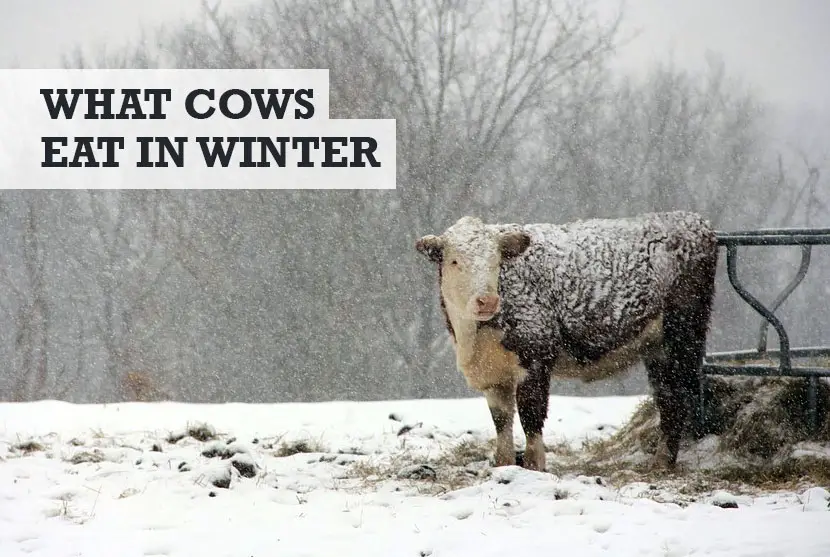When winter arrives, foliage and grass starts to die down, go brown and wither away. As grass is the main source of food for cows and other ranch animals, you might wonder what cows eat during winter. And more so for wild cows who don’t have the food source from humans. Here’s how it works…
What do cows eat during winter? Farmed cows eat hay in winter time. Other food fed to cows in cold winter months can also include maize silage or arable whole crop silage when there is no grass to eat or the ground is covered in snow and ice.
When it comes to cattle not on a farm, wild cows will eat grass and leaves which they can actively seek out. Wild mountain cows are a classic example, as they will travel to the foot of the mountain in winter where it will be warmer and more vegetation is available.
If you’re planning on starting a ranch or keeping cattle and you want to know more about healthy foods to feed your cows during winter, read on. I explain the types of food cows can eat in cold climates.

What do cows eat during winter?
Cattle and grass fed cows will eat hay, corn, wheat, and cover crops in winter. Here’s a bit more detail on this particular diet and why.
1. Hay
Grass fed cows still get fed grass during the winter but it’s in the form of hay. The hay is harvested before the winter and before the grass goes dormant. Hay is then rolled into large round bales during the fall which will then be used to feed the cows during the winter months.
How much hay do cows eat in winter?
The cows will still roam around pastures during winter. So, ranches load these large bales of hay onto their trucks and place them around the fields where the cows roam.
The cows will then eat from the bales. This is done on a daily basis as cows eat as much as 24 pounds of hay a day.
2. Corn
After harvesting corn, half the weight of a corn plant is left behind in the stalk, husk, and cob. This is a great source of food for cows.
The grass fed cows will eat whatever is left behind of the corn plant after it’s been harvested. The advantage is that cows also leave behind a nitrogen-rich, organic fertilizer on the ground that helps prepare the soil for next season’s crops.
3. Wheat
In certain parts of the states such as Kansas wheat is often planted in the fall and harvested in the summer. If you’re not familiar with winter wheat you’d mistake it for grass. Winter wheat is an excellent source of food for cows and calves during winter.
Over 2 million grass fed cows will graze on winter wheat every year.
4. Cover crops
After harvesting crops, fields will be susceptible to bare earth. To prevent topsoil erosion, ranches will plant cover crops over a field. Cover crops are plants that provide temporary cover over soil to prevent topsoil runoff and it helps control weeds.
On the other hand, cover crops also provide a source of nutrition for grazing cows.
Handy Hint: With the winter also comes wet weather. Here are some interesting facts about cows liking (or not) the rain.

Related questions
Don’t stop, there’s a lot more to a cow’s diet during winter. Here’s the most common questions people would ask.
What do wild cows eat in winter?
Food for wild cows will vary depending on where they live. Wild cows that live in zoos will get fed high-fiber and low carb pellets. On the other hand, cows that live in the wild and don’t have humans to feed them may eat dried grass stubs and shrubs.
Some feral cows live in forests when green lands aren’t available. These cows will eat saplings, ferns, and shrubs.
What do grass fed cows eat in winter?
Grass fed cows will eat hay during the winter months. The hay is harvested during the summer to prepare food for the cattle when it snows or when grass goes dormant. The hay is placed on pastures by ranches so that cows can feed.
How much hay do cows eat in winter?
Cows do et more in the winter. During the winter months a cows food intake will increase by 20%. The cold can impact your cattle but feeding them a certain way can increase their body temperatures. Before the temperatures drop, ranchers may increase cow feed.
Increasing cow feed by 20% will boost fermentation in the rumen which is part of a cow’s digestive system. By providing cows with more energy and increasing food in the rumen it will boost fermentation which helps the cow retain heat during winter.
Do cows need to take supplements in winter?
Some ranchers may provide supplements to cows when there is a nutrition deficiency or to complete the diet of a cow’s feeding system. Most cows will require supplements during winter to meet demands of lactation, general maintenance, and pregnancy.
By-product feedstuffs or commercial feed blends are commonly used as winter supplements for cows. The ingredients in these supplements can contain crude protein or total digestible nutrients. These supplements are used to substitute low quality forage.
Are dairy and beef cows feed differently during winter?
Beef cows have a primary grass fed diet all year round. So, they’ll live on pastures where they’ll get fed barrels of hay or where they can graze. Dairy cows are fed a grain-based diet which may require feed storage.
Furthermore, beef cows tend to live outside all year round but dairy cows need more shelter especially during the winter.
Can cows eat snow during winter?
Many people wonder if cows can eat snow for their water intake. The good news is that cows can eat snow. In fact, cows sometimes eat 30 to 40 pounds of snow a day to meet their daily water intake. Cows that have access to water may also still eat 7 to 25 pounds of snow a day.
Cows that eat snow are perfectly healthy and show no signs of decreased performance. What’s more, there is no difference in live weight between cows that eat snow or ones that don’t.
Handy Hint: In winter salt will often be placed on roads to stop vehicles skidding. It can also cause hazards though, as wild cows will lick the salt so wander into the road.
How much water do cows need in winter?
Water is just as important as food for your cows during the winter months. Cows may drink 1 gallon of water per 100 pounds of body weight. During summer cows will drink 2 gallons of water per 100 pounds of body weight.
Additionally, lactating cows need twice as much water compared to dry cows. You must provide your cows with fresh, clean water that’s free from manure and contaminants.

What causes a cow to stop eating?
There have been instances where cows will stop eating. There are many situations that can cause your cow to lose its appetite. One of the most common reasons is stress. When a cow experiences stress it disrupts the pH of the rumen which can lower a cow’s appetite.
Another reason why your cow may stop eating is because of an infection. If you notice your cow isn’t grazing it may have a virus or a disease. You should then separate the cow from the rest of the herd and contact a vet immediately.
Giving your cow rotten feed can also cause them to stop eating. Always provide fresh feed to your cows daily because they will refuse to eat forage that is moldy or rotten.
Lastly, dirty living conditions can also cause your cows to stop eating. Make sure your cows have a clean environment so that it doesn’t cause them stress which can lower their appetite.
What do cows eat in summer?
According to This is Dairy Farming, cows tend to eat a grass diet in the summer. Here’s a quote from them:
The majority of British dairy cows eat grass during the summer and silage (preserved grass or maize) in the winter. This is usually supplemented with dry feeds such as cereals and protein feeds with added vitamins and minerals.
Conclusion
If you are thinking about getting cows, or are worried about wild cows living near you in winter, then don’t be. Wild cows have evolved to be able to find and forage for food in the cold.
Farm bred and grass fed cows also have plenty of food options available as you can see.
You might also like…
Image of a cow in winter snow via https://pixabay.com/photos/nature-cows-farm-snow-animal-2662688/

